heating FORD MUSTANG 2002 4.G Owners Manual
[x] Cancel search | Manufacturer: FORD, Model Year: 2002, Model line: MUSTANG, Model: FORD MUSTANG 2002 4.GPages: 264, PDF Size: 2.56 MB
Page 1 of 264
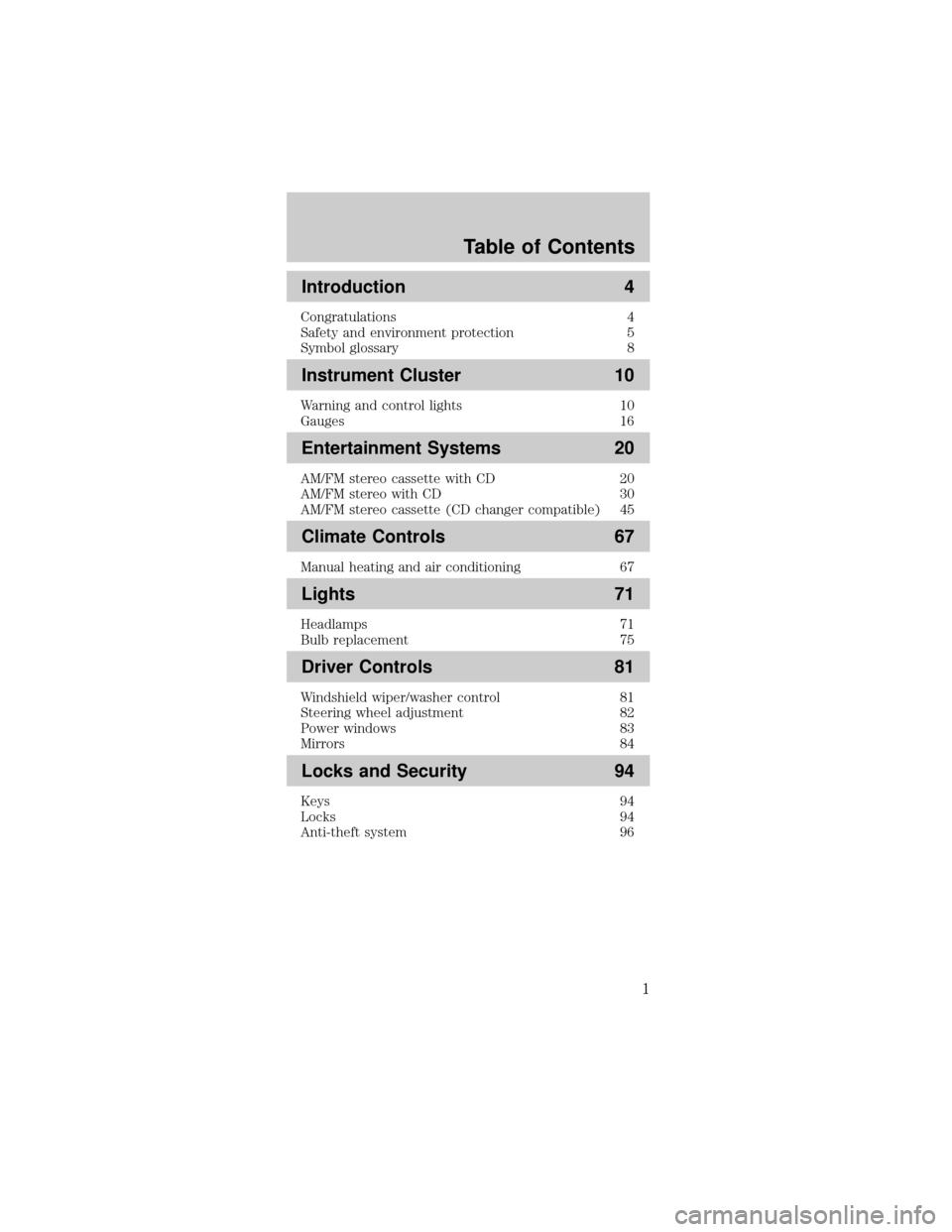
Introduction 4
Congratulations 4
Safety and environment protection 5
Symbol glossary 8
Instrument Cluster 10
Warning and control lights 10
Gauges 16
Entertainment Systems 20
AM/FM stereo cassette with CD 20
AM/FM stereo with CD 30
AM/FM stereo cassette (CD changer compatible) 45
Climate Controls 67
Manual heating and air conditioning 67
Lights 71
Headlamps 71
Bulb replacement 75
Driver Controls 81
Windshield wiper/washer control 81
Steering wheel adjustment 82
Power windows 83
Mirrors 84
Locks and Security 94
Keys 94
Locks 94
Anti-theft system 96
Table of Contents
1
Page 16 of 264
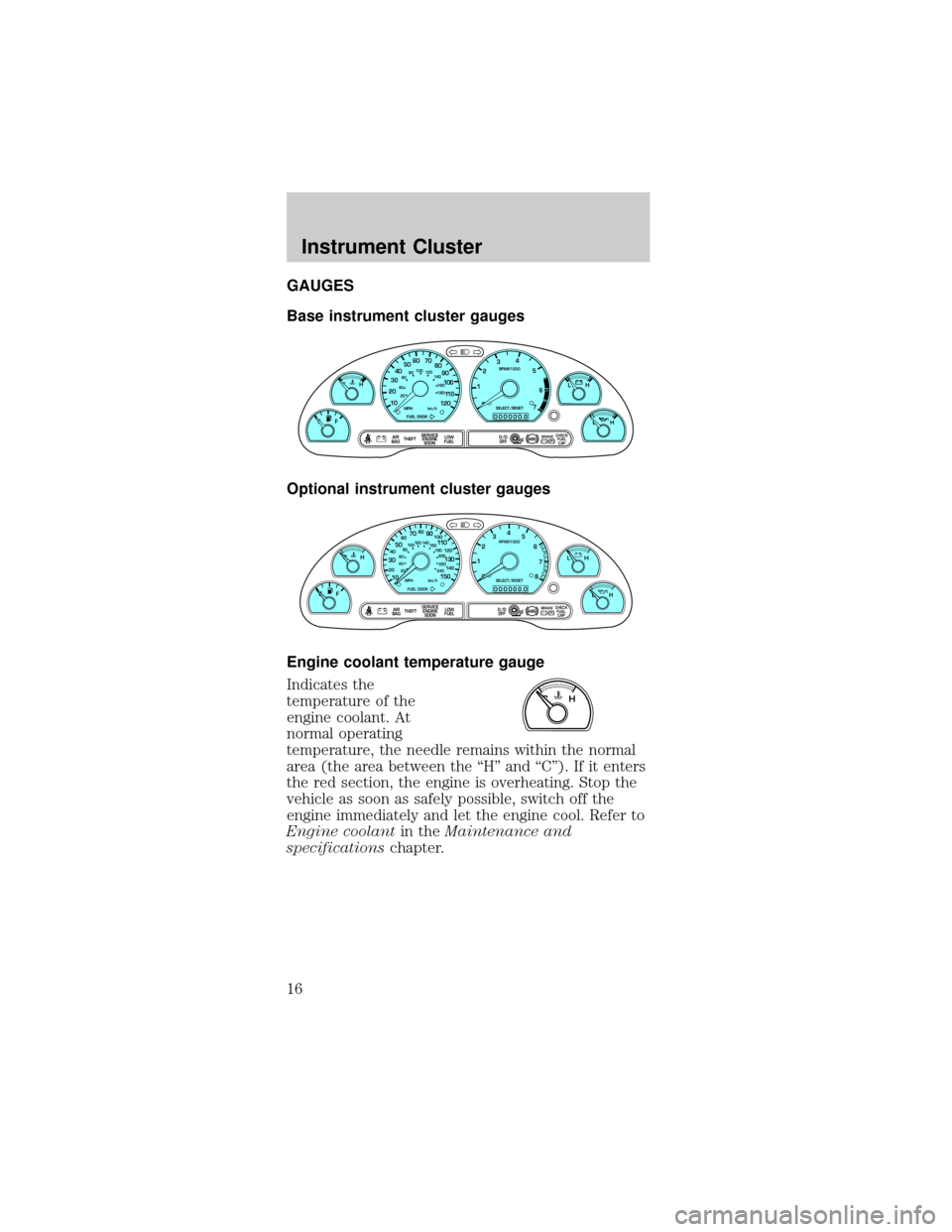
GAUGES
Base instrument cluster gauges
Optional instrument cluster gauges
Engine coolant temperature gauge
Indicates the
temperature of the
engine coolant. At
normal operating
temperature, the needle remains within the normal
area (the area between the ªHº and ªCº). If it enters
the red section, the engine is overheating. Stop the
vehicle as soon as safely possible, switch off the
engine immediately and let the engine cool. Refer to
Engine coolantin theMaintenance and
specificationschapter.
P! BRAKE
L C
EFH
LH
10 203020 406080100
120
140
160
180
405060 70
80
90
100
11 0
1204
5
6
7 3
2
1
H
THEFT
RPMX1000
FUEL DOORSELECT/RESET
LOW
FUELO/D
OFF AIR
BAGSERVICE
ENGINE
SOON
MPH km/h
ABS
00000 00.
CHECK
FUEL
CAP
P! BRAKE
0
00000 00
FH
H
102040608020 40608010 012 0 14 0
160
180
200
220
240
100
120
140
305070 90
110
13 0
1504
5
6
7
8 3
2
1
H
THEFT
RPMX1000
FUEL DOORSELECT/RESET
LOW
FUELO/D
OFF AIR
BAGSERVICE
ENGINE
SOON
MPH km/h
ABS
.
L
LCHECK
FUEL
CAP
CH
Instrument Cluster
16
Page 67 of 264
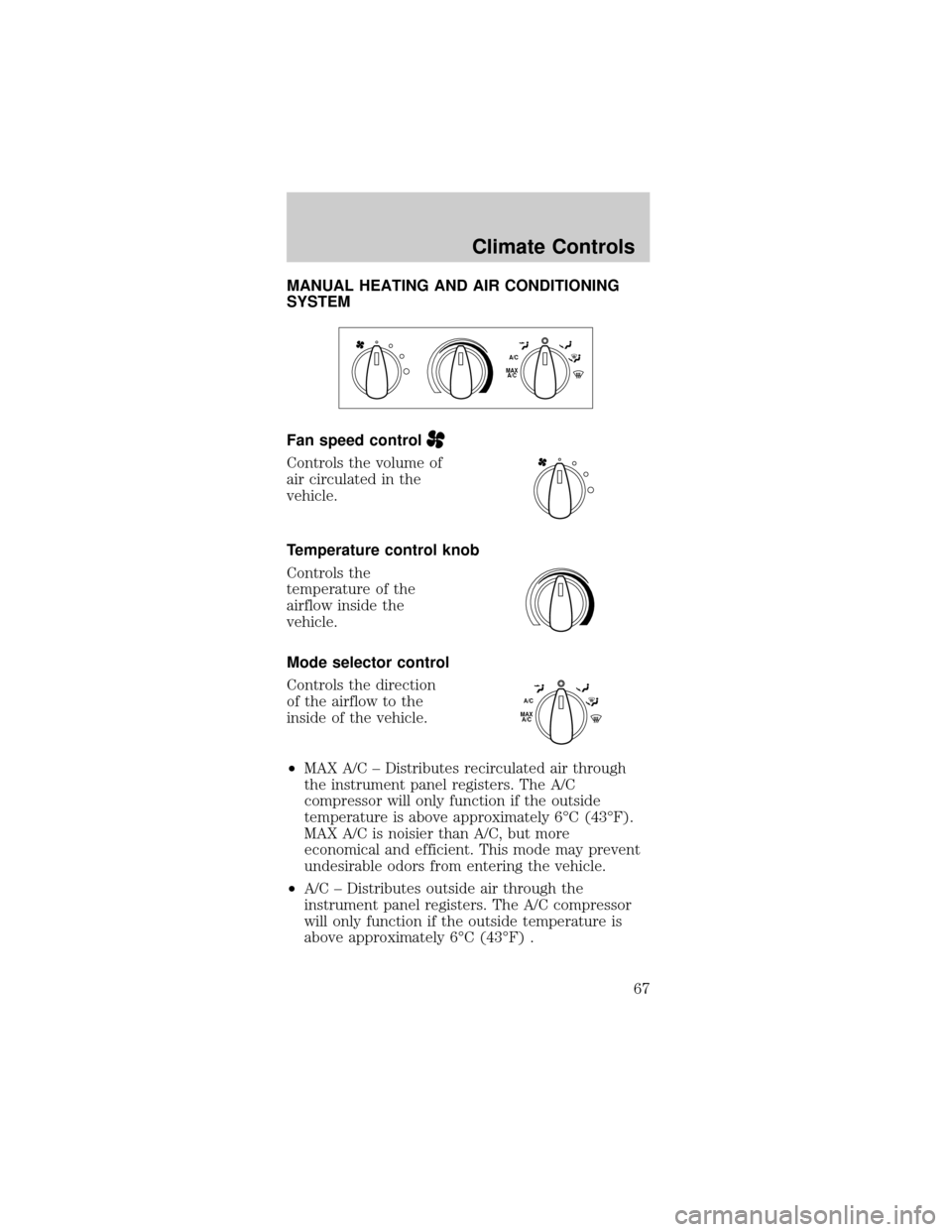
MANUAL HEATING AND AIR CONDITIONING
SYSTEM
Fan speed control
Controls the volume of
air circulated in the
vehicle.
Temperature control knob
Controls the
temperature of the
airflow inside the
vehicle.
Mode selector control
Controls the direction
of the airflow to the
inside of the vehicle.
²MAX A/C ± Distributes recirculated air through
the instrument panel registers. The A/C
compressor will only function if the outside
temperature is above approximately 6ÉC (43ÉF).
MAX A/C is noisier than A/C, but more
economical and efficient. This mode may prevent
undesirable odors from entering the vehicle.
²A/C ± Distributes outside air through the
instrument panel registers. The A/C compressor
will only function if the outside temperature is
above approximately 6ÉC (43ÉF) .
MAX
A/CA/C
MAX
A/CA/C
Climate Controls
67
Page 141 of 264
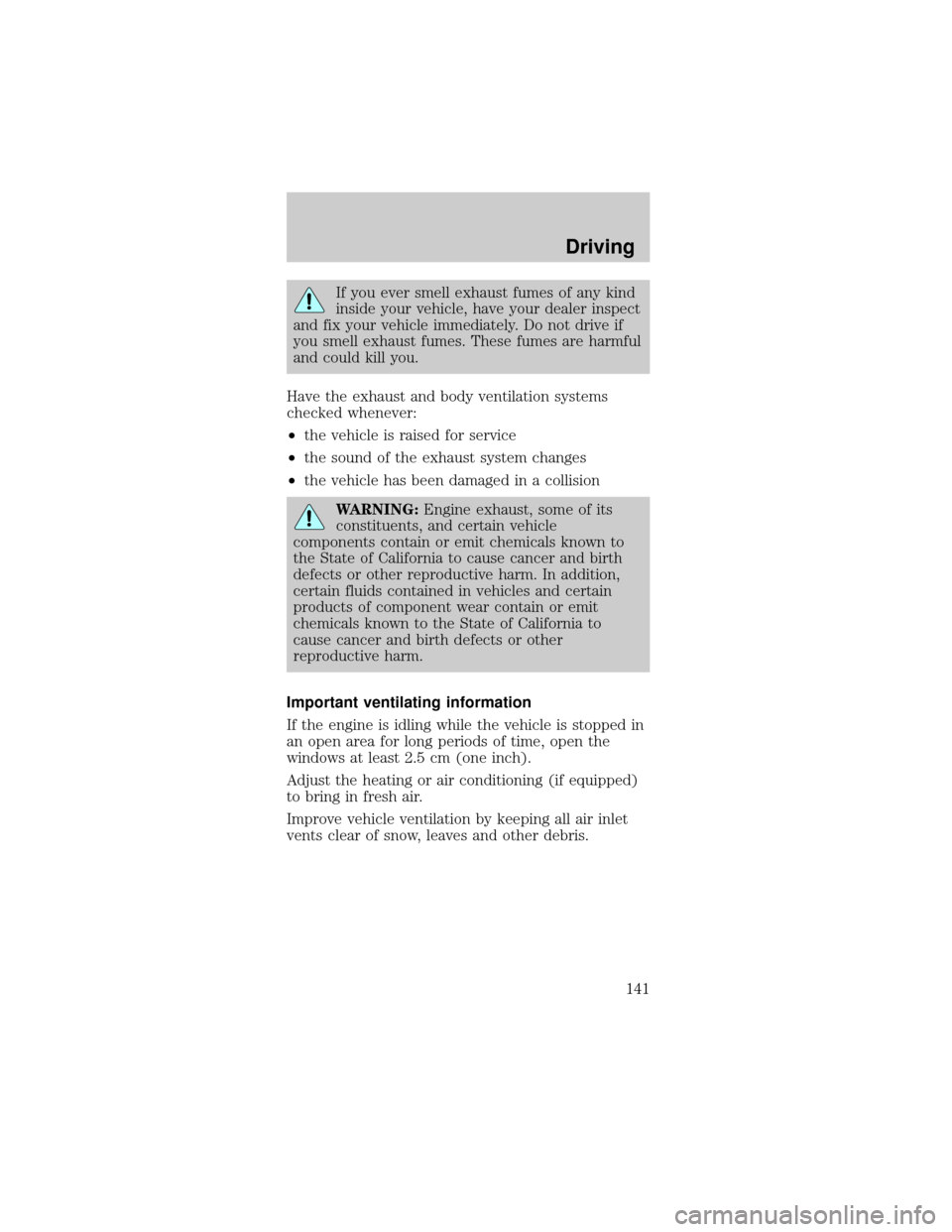
If you ever smell exhaust fumes of any kind
inside your vehicle, have your dealer inspect
and fix your vehicle immediately. Do not drive if
you smell exhaust fumes. These fumes are harmful
and could kill you.
Have the exhaust and body ventilation systems
checked whenever:
²the vehicle is raised for service
²the sound of the exhaust system changes
²the vehicle has been damaged in a collision
WARNING:Engine exhaust, some of its
constituents, and certain vehicle
components contain or emit chemicals known to
the State of California to cause cancer and birth
defects or other reproductive harm. In addition,
certain fluids contained in vehicles and certain
products of component wear contain or emit
chemicals known to the State of California to
cause cancer and birth defects or other
reproductive harm.
Important ventilating information
If the engine is idling while the vehicle is stopped in
an open area for long periods of time, open the
windows at least 2.5 cm (one inch).
Adjust the heating or air conditioning (if equipped)
to bring in fresh air.
Improve vehicle ventilation by keeping all air inlet
vents clear of snow, leaves and other debris.
Driving
141
Page 216 of 264
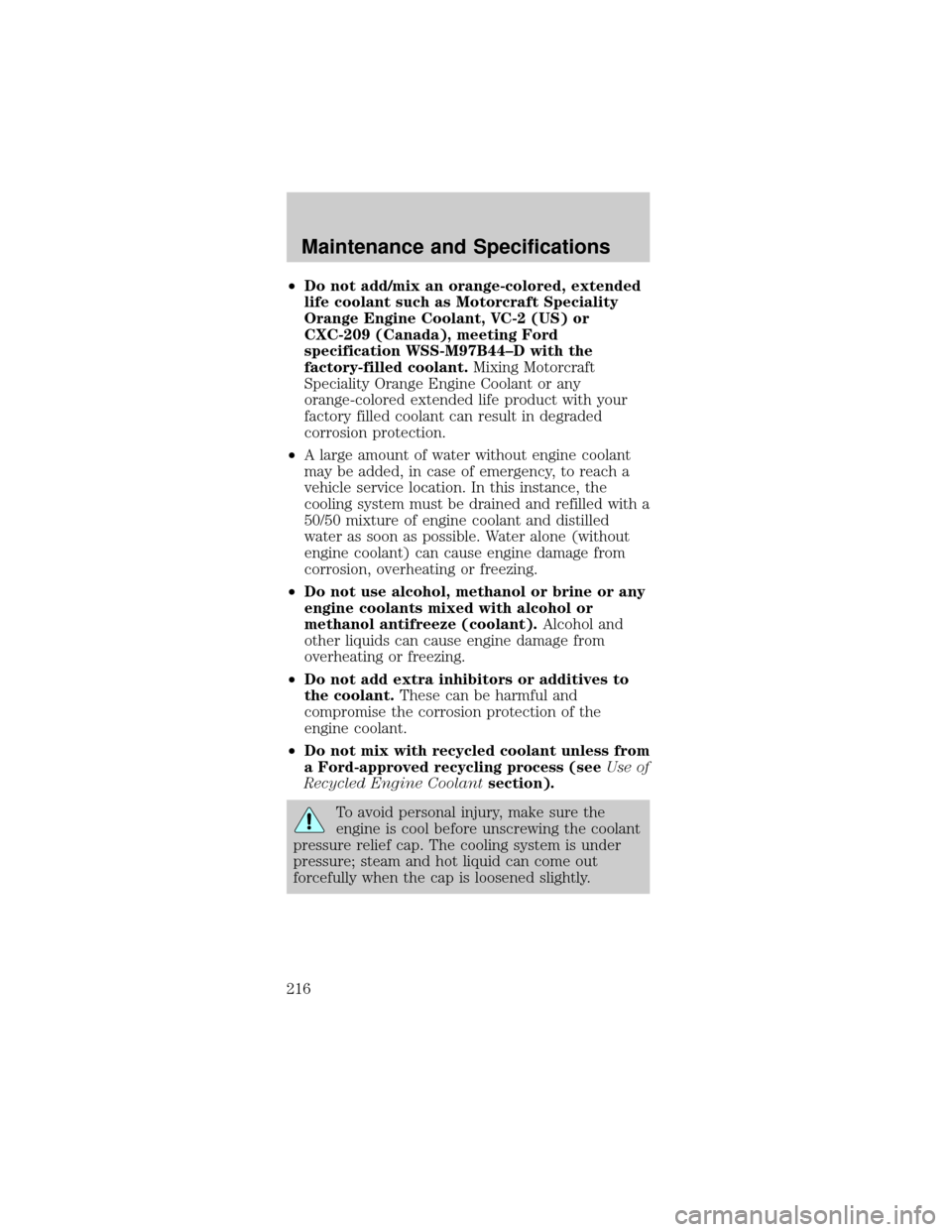
²Do not add/mix an orange-colored, extended
life coolant such as Motorcraft Speciality
Orange Engine Coolant, VC-2 (US) or
CXC-209 (Canada), meeting Ford
specification WSS-M97B44±D with the
factory-filled coolant.Mixing Motorcraft
Speciality Orange Engine Coolant or any
orange-colored extended life product with your
factory filled coolant can result in degraded
corrosion protection.
²A large amount of water without engine coolant
may be added, in case of emergency, to reach a
vehicle service location. In this instance, the
cooling system must be drained and refilled with a
50/50 mixture of engine coolant and distilled
water as soon as possible. Water alone (without
engine coolant) can cause engine damage from
corrosion, overheating or freezing.
²Do not use alcohol, methanol or brine or any
engine coolants mixed with alcohol or
methanol antifreeze (coolant).Alcohol and
other liquids can cause engine damage from
overheating or freezing.
²Do not add extra inhibitors or additives to
the coolant.These can be harmful and
compromise the corrosion protection of the
engine coolant.
²Do not mix with recycled coolant unless from
a Ford-approved recycling process (seeUse of
Recycled Engine Coolantsection).
To avoid personal injury, make sure the
engine is cool before unscrewing the coolant
pressure relief cap. The cooling system is under
pressure; steam and hot liquid can come out
forcefully when the cap is loosened slightly.
Maintenance and Specifications
216
Page 219 of 264
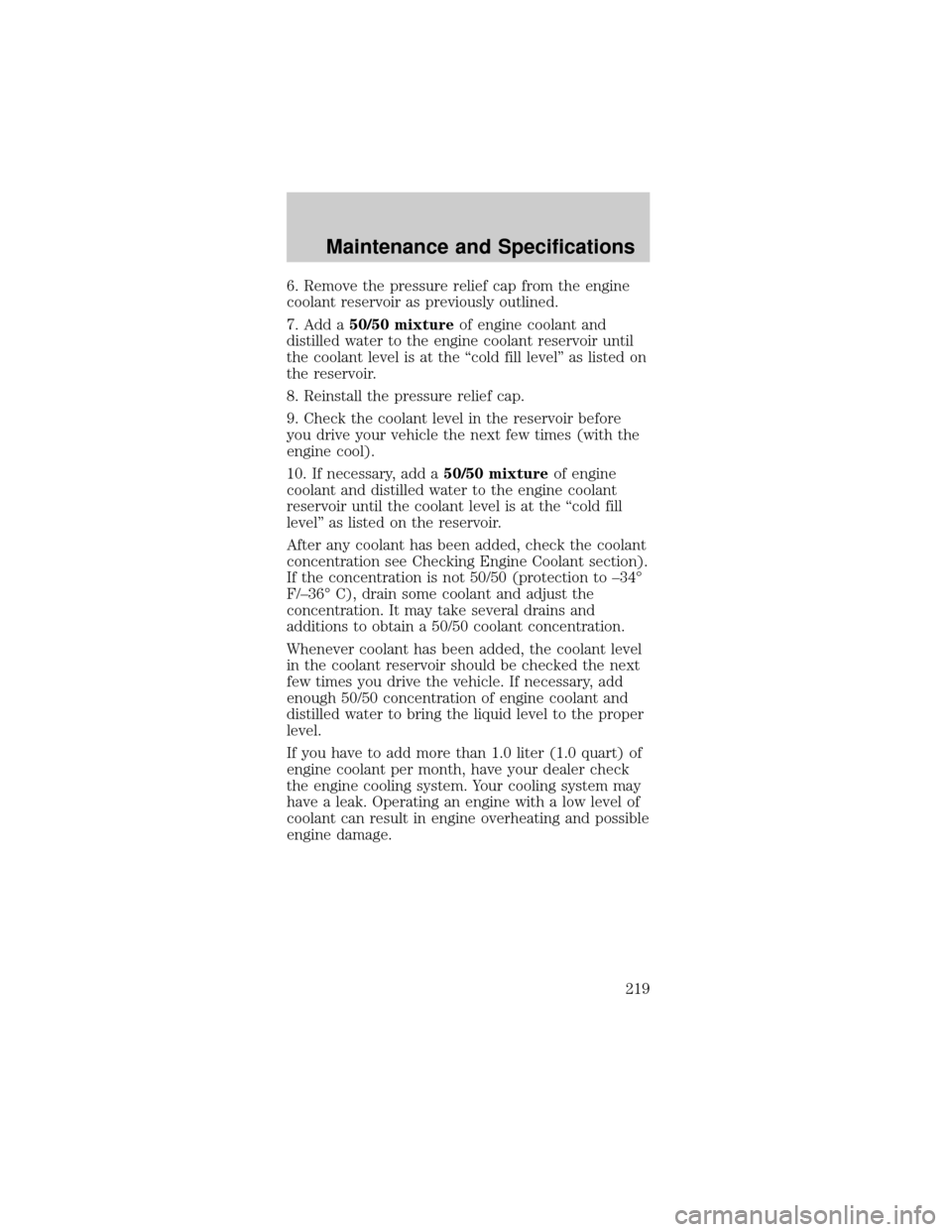
6. Remove the pressure relief cap from the engine
coolant reservoir as previously outlined.
7. Add a50/50 mixtureof engine coolant and
distilled water to the engine coolant reservoir until
the coolant level is at the ªcold fill levelº as listed on
the reservoir.
8. Reinstall the pressure relief cap.
9. Check the coolant level in the reservoir before
you drive your vehicle the next few times (with the
engine cool).
10. If necessary, add a50/50 mixtureof engine
coolant and distilled water to the engine coolant
reservoir until the coolant level is at the ªcold fill
levelº as listed on the reservoir.
After any coolant has been added, check the coolant
concentration see Checking Engine Coolant section).
If the concentration is not 50/50 (protection to ±34É
F/±36É C), drain some coolant and adjust the
concentration. It may take several drains and
additions to obtain a 50/50 coolant concentration.
Whenever coolant has been added, the coolant level
in the coolant reservoir should be checked the next
few times you drive the vehicle. If necessary, add
enough 50/50 concentration of engine coolant and
distilled water to bring the liquid level to the proper
level.
If you have to add more than 1.0 liter (1.0 quart) of
engine coolant per month, have your dealer check
the engine cooling system. Your cooling system may
have a leak. Operating an engine with a low level of
coolant can result in engine overheating and possible
engine damage.
Maintenance and Specifications
219
Page 239 of 264
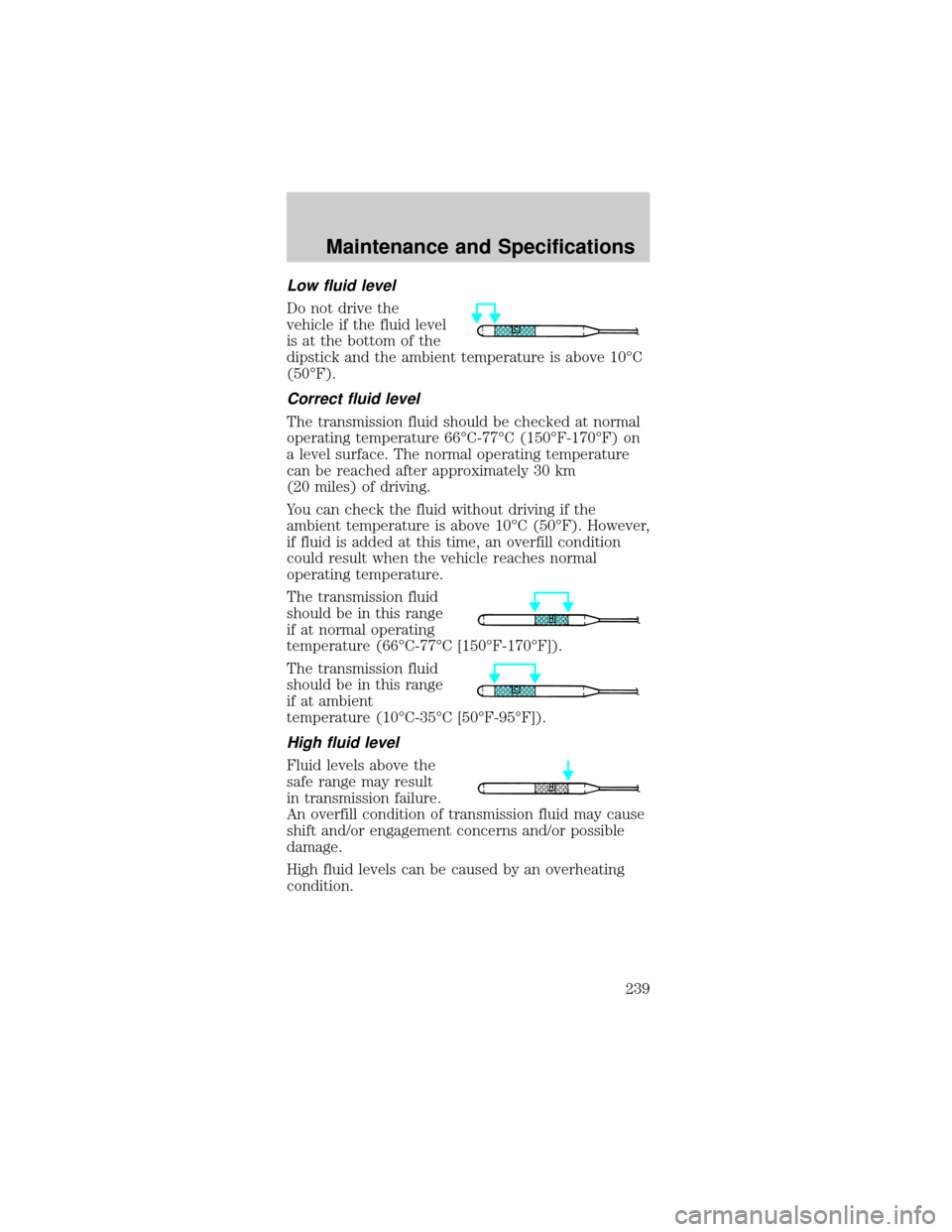
Low fluid level
Do not drive the
vehicle if the fluid level
is at the bottom of the
dipstick and the ambient temperature is above 10ÉC
(50ÉF).
Correct fluid level
The transmission fluid should be checked at normal
operating temperature 66ÉC-77ÉC (150ÉF-170ÉF) on
a level surface. The normal operating temperature
can be reached after approximately 30 km
(20 miles) of driving.
You can check the fluid without driving if the
ambient temperature is above 10ÉC (50ÉF). However,
if fluid is added at this time, an overfill condition
could result when the vehicle reaches normal
operating temperature.
The transmission fluid
should be in this range
if at normal operating
temperature (66ÉC-77ÉC [150ÉF-170ÉF]).
The transmission fluid
should be in this range
if at ambient
temperature (10ÉC-35ÉC [50ÉF-95ÉF]).
High fluid level
Fluid levels above the
safe range may result
in transmission failure.
An overfill condition of transmission fluid may cause
shift and/or engagement concerns and/or possible
damage.
High fluid levels can be caused by an overheating
condition.
Maintenance and Specifications
239
Page 258 of 264

A
ABS (see Brakes) ... 143
Air bag
supplemental restraint
system .............. 120±121
and child safety
seats ....................... 123
description ............ 121
disposal .................. 126
driver air bag ........ 123
indicator light... 11, 125
operation ............... 123
passenger air bag . 123
Air cleaner filter ..... 246
Air conditioning
manual heating and
air conditioning
system ..................... 67
Antifreeze (see
Engine coolant) ...... 213
Anti-lock brake system
(see Brakes) .... 143±144
Anti-theft system
warning light ........... 11
Audio system
(see Radio) .... 20, 45±46
Automatic
transmission ............ 148
driving an automatic
overdrive ............... 150
fluid, adding .......... 238
fluid, checking ...... 238
fluid, refill
capacities ............... 247
fluid, specification.. 251
Auxiliary power
point ........................... 83Axle
lubricant
specifications. 249, 251
refill capacities ...... 247
traction lok ............ 147
B
Battery ..................... 210
acid, treating
emergencies .......... 210
charging system
warning light ........... 11
jumping a disabled
battery ................... 174
maintenance-free .. 210
replacement,
specifications ........ 246
servicing ................ 210
voltage gauge .......... 17
BeltMinder ............... 114
Brakes .............. 142, 145
anti-lock ......... 143±144
anti-lock brake
system (ABS)
warning light ... 14, 144
brake warning light.. 15
fluid, checking
and adding ............ 235
fluid, refill
capacities ............... 247
fluid,
specifications. 249, 251
lubricant
specifications. 249, 251
parking .................. 142
shift interlock ........ 148
Break-in period ........... 6
Bulbs .......................... 75
Index
258
Page 259 of 264

C
Capacities for
refilling fluids .......... 247
Cargo net ................... 83
CD player ............ 45±46
CD-single premium ... 20
Certification Label .. 253
Changing a tire ....... 170
Child safety
restraints ................. 127
child safety belts .. 127
Child safety seats .... 128
attaching with
tether straps ......... 132
in front seat .......... 129
in rear seat ............ 129
Cleaning your vehicle
engine
compartment ......... 194
exterior .................. 199
instrument
cluster lens ............ 198
instrument panel .. 197
interior ................... 198
plastic parts .......... 196
safety belts ............ 199
washing .................. 192
waxing ................... 192
wheels .................... 193
windows ................ 199
wiper blades .......... 196
Climate control
(see Air conditioning
or Heating) ................ 67
Clock .............. 25, 37, 52
Clutch
adjusting ................ 237operation while
driving ................... 154
recommended
shift speeds ........... 155
Console ...................... 89
Controls
power seat ............. 105
Convertible ................ 90
cleaning ................. 197
installation of
the boot ................... 92
lowering the
convertible top ........ 90
raising the
convertible top ........ 93
Coolant
checking and
adding .................... 213
refill
capacities ....... 220, 247
specifications. 249, 251
Cruise control (see
Speed control) .......... 85
Customer
Assistance ................ 162
Ford accessories
for your vehicle .... 200
Ford Extended
Service Plan .......... 182
Getting assistance
outside the U.S.
and Canada ........... 188
Getting roadside
assistance .............. 162
Getting the service
you need ............... 180
Ordering additional
owner's literature... 189
Index
259
Page 261 of 264

low fuel warning
light .......................... 13
octane rating.. 225, 251
quality .................... 226
running out of fuel 226
safety information
relating to automotive
fuels ....................... 221
Fuses ................ 165±166
G
Gas cap
(see Fuel cap) ... 13, 224
Gas mileage (see
Fuel economy) ........ 227
Gauges ....................... 16
battery voltage
gauge ....................... 17
engine coolant
temperature gauge... 16
engine oil pressure
gauge ....................... 17
fuel gauge ................ 18
odometer ................. 18
speedometer ........... 18
tachometer .............. 19
trip odometer .......... 19
GAWR (Gross Axle
Weight Rating) ........ 158
definition ............... 158
driving with a
heavy load ............. 158
location .................. 158
GVWR (Gross Vehicle
Weight Rating) ........ 158
calculating ............. 158
definition ............... 158
driving with a
heavy load ............. 158
location .................. 158H
Hazard flashers ....... 163
Head restraints ....... 104
Headlamps ................. 71
aiming ...................... 73
bulb specifications .. 75
daytime running
lights ........................ 71
flash to pass ............ 72
high beam ......... 10, 72
replacing bulbs ....... 76
turning on and off .. 71
warning chime ........ 15
Heating
heating and air
conditioning
system ..................... 67
Hood ........................ 203
I
Ignition ............. 136, 251
removing the key .. 157
Infant seats
(see Safety seats) ... 128
Inspection/maintenance
(I/M) testing ............ 233
Instrument panel
cleaning ................. 197
cluster .............. 10, 198
lighting up panel
and interior ............. 72
J
Jack .......................... 170
positioning ............. 170
storage ................... 170
Jump-starting your
vehicle ...................... 174
Index
261